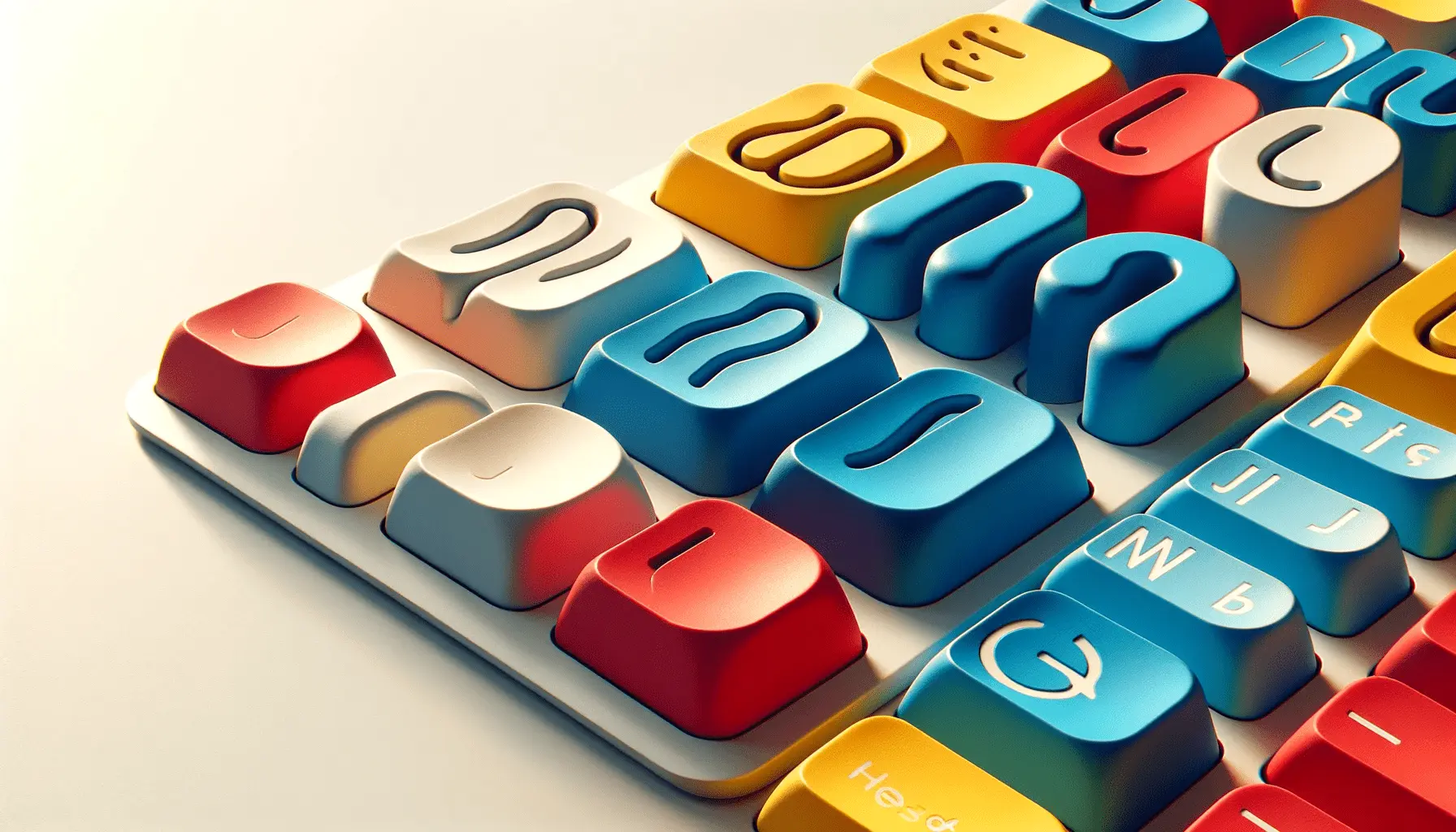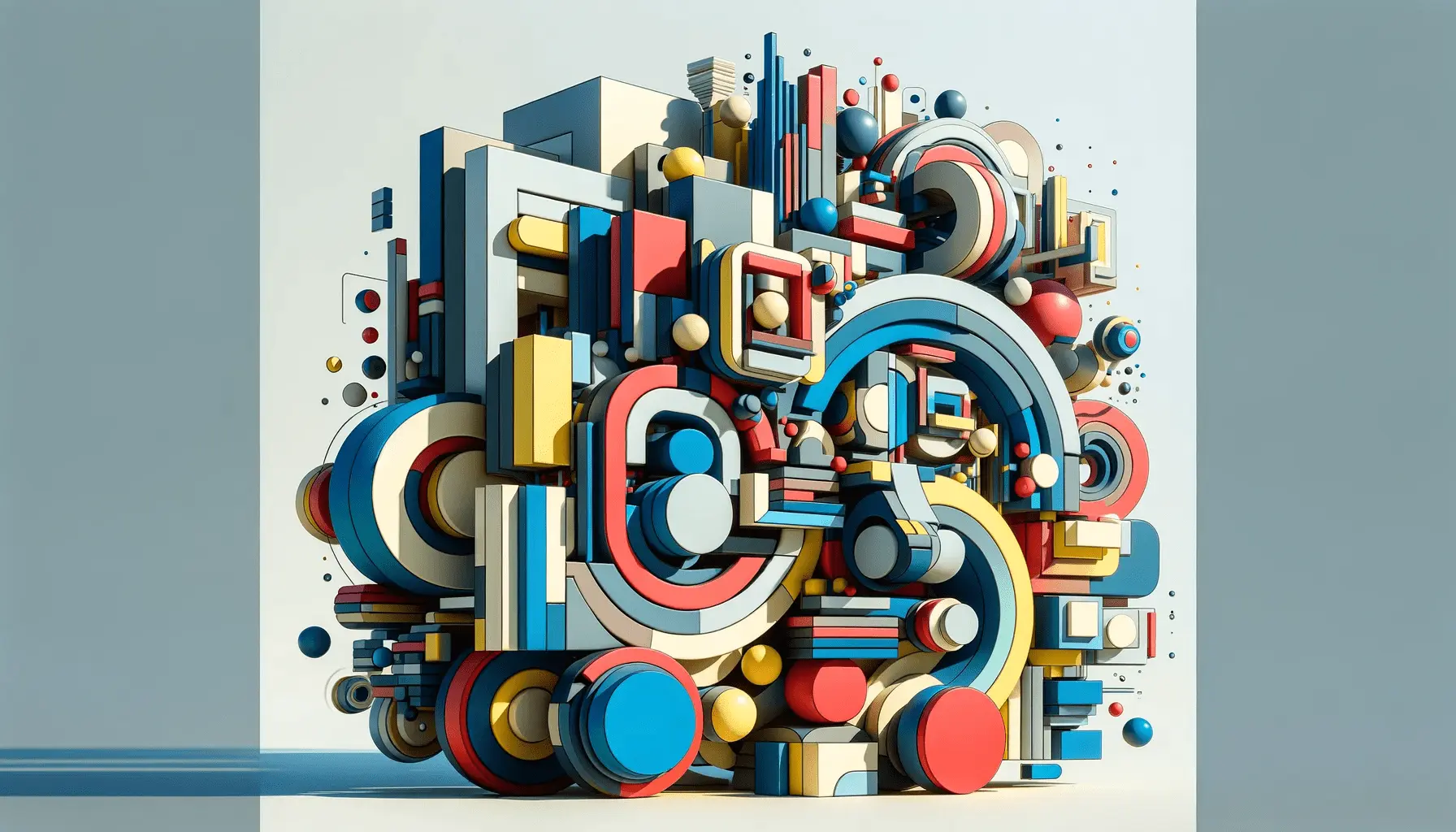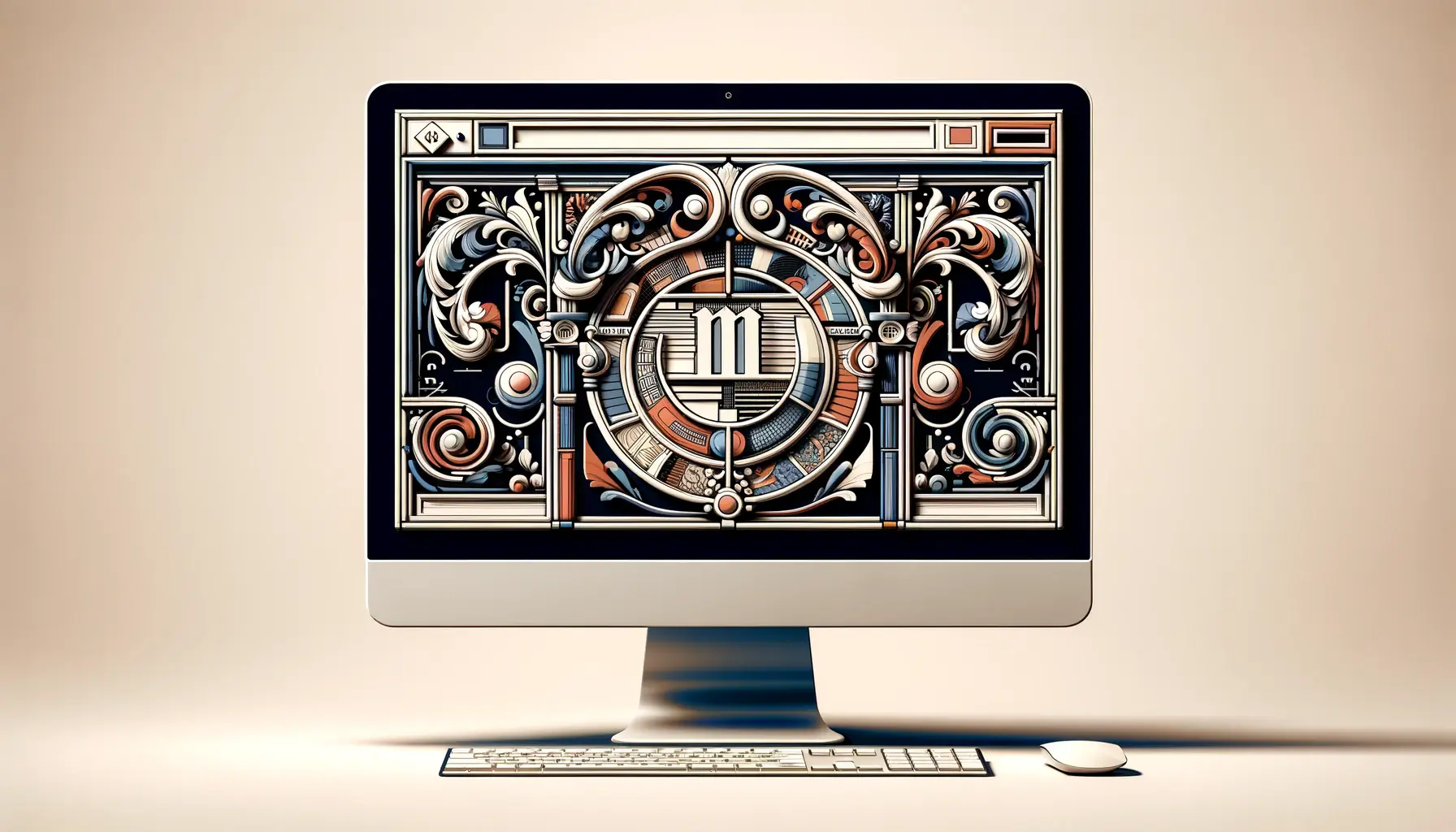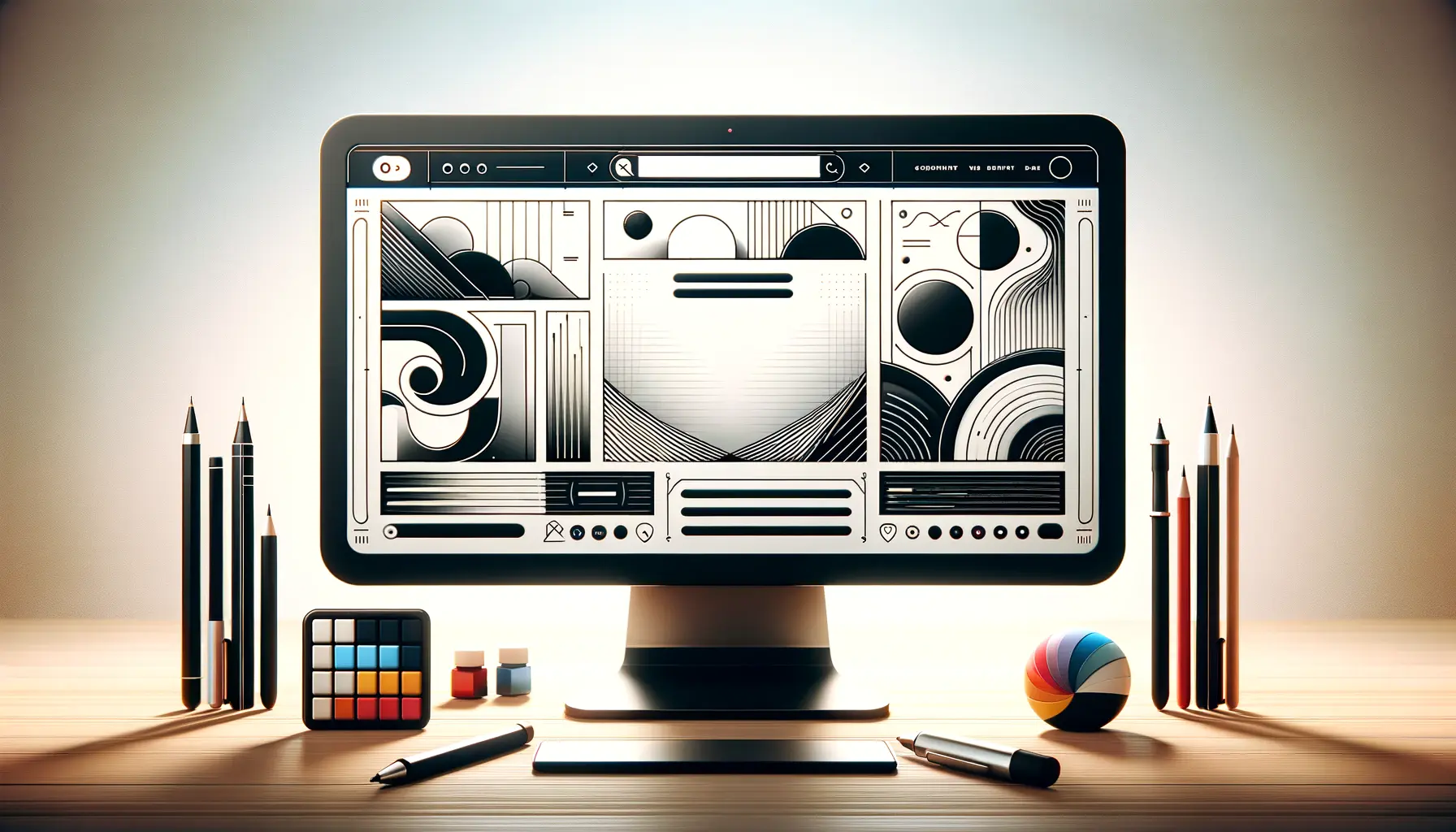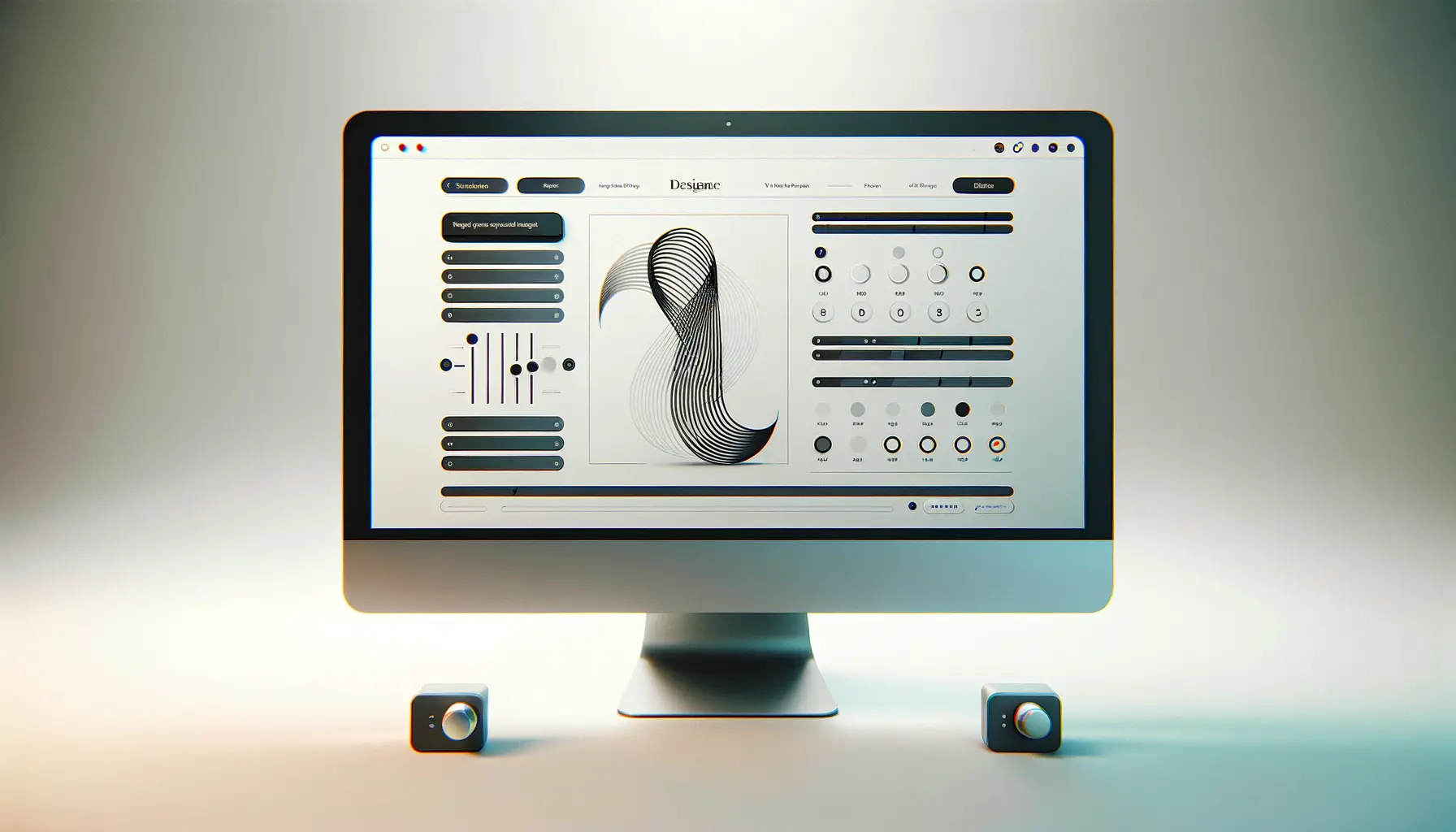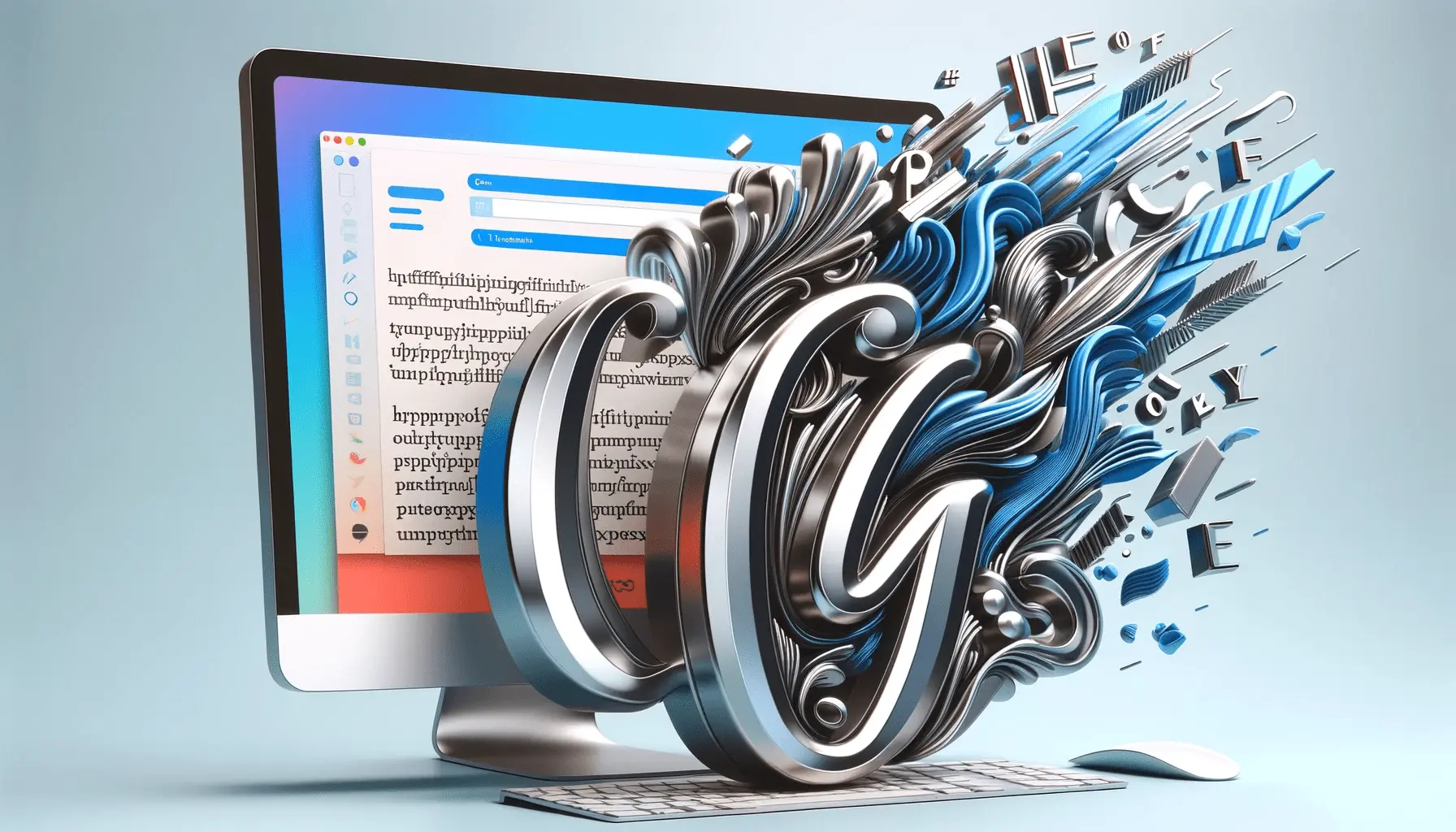In the digital age, where the internet is saturated with content, standing out becomes paramount for any website.
The use of bold fonts has emerged as a powerful tool in achieving a strong web presence, captivating the audience’s attention at first glance.
This typographic strategy is not just about aesthetics; it’s a deliberate choice to communicate strength, confidence, and clarity.
Bold fonts, by their very nature, command attention and make a statement, setting the tone for the entire website.
Typography, especially bold typography, plays a crucial role in the user experience and interface design.
It’s not merely about making certain texts stand out; it’s about creating a visual hierarchy, guiding the visitors’ eyes through the content, and enhancing the overall readability of the website.
In a world where users skim through content, bold fonts act as visual anchors, emphasizing key messages and calls to action, thereby improving user engagement and conversion rates.
- The Importance of Typography in Web Design
- Best Practices for Using Bold Fonts
- Impact of Bold Typography on User Experience
- Psychological Effects of Bold Typography
- Typography and Brand Identity
- Integrating Bold Typography with UX/UI Design
- Future Trends in Bold Typography
- Embracing Bold Typography for a Stronger Web Presence
- Bold Fonts in Web Design FAQs
The Importance of Typography in Web Design
Typography in web design goes beyond the choice of font; it involves the arrangement and appearance of text, impacting how information is perceived and absorbed.
A well-thought-out typographic strategy can significantly enhance a website’s usability and aesthetic appeal.
Bold fonts, in particular, play a pivotal role in this strategy, offering a dynamic range of applications from headlines to button texts.
Their strategic use can dramatically influence the user’s journey, making information not only more accessible but also more compelling.
Choosing the right bold font is crucial.
It must align with the website’s overall style and message, ensuring coherence and consistency across the design.
The boldness of a font should enhance the text’s visibility without compromising legibility.
This balance is key to maintaining a user-friendly interface that captivates and retains the audience’s attention.
The impact of bold typography extends beyond visual appeal; it’s a tool for effective communication, enabling websites to convey their messages with greater impact and precision.
Creating a Visual Hierarchy
Visual hierarchy is one of the fundamental principles of web design, dictating the order in which a user processes information on a page.
Bold fonts are instrumental in establishing this hierarchy, drawing attention to primary content, such as headlines and key points, while supporting text plays a secondary role.
This differentiation guides users through the content, enhancing their understanding and retention of information.
The use of bold fonts in creating a visual hierarchy not only prioritizes content but also adds depth to the design, making the web page more engaging and easier to navigate.
By clearly defining what should be noticed first, designers can control the user’s journey, directing them to the most important sections, ultimately leading to a more satisfying user experience.
The strategic use of bold fonts in web design not only captures attention but also significantly enhances user engagement and communication effectiveness.
Best Practices for Using Bold Fonts
Integrating bold fonts into web design requires a nuanced approach to ensure that the text not only stands out but also complements the overall design.
Here are some best practices for using bold fonts effectively:
Choosing the Right Font
The selection of the bold font is critical.
It should align with the website’s theme and purpose.
A bold font that works well for a tech startup’s website might not suit a luxury brand’s online presence.
The key is to choose a font that reflects the brand’s personality and resonates with its target audience.
Moreover, the chosen bold font should maintain its legibility across different devices and screen sizes.
This ensures that the message remains clear and impactful, regardless of how the user accesses the website.
Balance and Contrast
Using bold fonts effectively involves striking the right balance and creating contrast within the webpage.
This can be achieved through:
- Color: Employing bold fonts in contrasting colors can make them stand out against the background, enhancing readability.
- Size: Adjusting the size of the bold text in relation to other elements on the page can emphasize its importance.
- Spacing: Adequate spacing around bold text improves its visibility and makes the webpage look less cluttered.
Limiting Use for Maximum Impact
While bold fonts are a powerful tool, their overuse can dilute their effectiveness.
It’s important to use bold fonts sparingly, focusing on key areas where you want to draw the user’s attention.
This selective use ensures that when a bold font is used, it carries more weight and significance, guiding the user’s focus to where it’s most needed.
Additionally, using bold fonts selectively helps maintain a clean and organized look on the webpage, preventing it from becoming overwhelming or difficult to navigate.
Remember, the goal of using bold fonts is to enhance the user’s experience, not to overshadow the content or make the page difficult to read.
Integrating with the Overall Design
The use of bold fonts should feel seamless within the website’s design.
It should complement the other design elements, such as color schemes, imagery, and layout.
Consistency in font usage across the website reinforces the brand identity and contributes to a cohesive user experience.
When bold fonts are integrated thoughtfully, they can elevate the design, making the website not only more attractive but also more functional.
This integration is key to creating a harmonious balance between style and substance, ensuring that the website effectively communicates its message while engaging the user visually.
Impact of Bold Typography on User Experience
The influence of bold typography on user experience (UX) extends far beyond mere aesthetics.
It plays a crucial role in how information is processed and perceived by users.
Bold fonts can significantly enhance the usability and accessibility of a website, making it more user-friendly and engaging.
Enhancing Readability and Scannability
One of the primary benefits of using bold typography is the improvement of text readability and scannability.
Websites have mere seconds to capture a user’s attention; bold fonts make critical information jump out, facilitating quick scanning.
This is particularly important in an era where users often browse websites on-the-go, using mobile devices.
By making headlines, key points, and calls to action stand out, bold typography ensures that users can quickly grasp the main messages without having to read every word on the page.
This efficiency in communication enhances the overall user experience, making websites more intuitive and easier to navigate.
Guiding User Navigation
Beyond readability, bold typography serves as visual cues that guide users through the website’s content flow.
By emphasizing certain elements over others, designers can subtly direct users’ attention to where it’s most needed, whether it’s towards a signup form, a special offer, or the next step in a navigational journey.
- Highlighting Calls to Action: Bold fonts make calls to action more prominent, increasing the likelihood of user engagement.
- Organizing Content: Using bold fonts to differentiate sections or categories helps users find the information they’re interested in more efficiently.
Contributing to Aesthetic Appeal and Brand Perception
The strategic use of bold typography also contributes to the aesthetic appeal of a website.
A well-chosen bold font can add character and style to a webpage, making it more visually interesting and engaging.
Furthermore, the type of bold font selected can reflect the brand’s personality, helping to shape users’ perceptions.
For instance, a bold, modern font might convey a sense of innovation and forward-thinking, suitable for tech companies, while a bold, elegant serif font could suggest sophistication and luxury, ideal for high-end brands.
This alignment between typography and brand identity reinforces the brand’s message and values, enhancing user trust and loyalty.
Incorporating bold typography thoughtfully within web design can transform the user experience, making websites not only more navigable and readable but also more aligned with the brand’s identity.
Psychological Effects of Bold Typography
The psychological impact of bold typography on web users is profound and multifaceted.
Fonts, especially when bold, do more than convey written information; they evoke emotions, create atmosphere, and can significantly influence user behavior and decision-making processes.
Understanding these psychological effects is crucial for designers aiming to create more engaging and effective websites.
Eliciting Emotional Responses
Bold typography has the power to elicit specific emotional responses from users.
The choice of a bold font can convey confidence, urgency, or importance, affecting how users feel about the content.
For example, a bold, sans-serif font may evoke feelings of modernity and professionalism, appealing to users looking for cutting-edge solutions.
Conversely, a bold, serif font might evoke a sense of tradition and reliability, resonating with users seeking stability and trustworthiness.
This emotional resonance is key to creating a connection between the website and its users, potentially influencing their engagement level and willingness to take action, such as making a purchase or signing up for a newsletter.
Influencing Perceptions and Decisions
The psychological impact of bold typography extends to influencing users’ perceptions and decisions.
The way information is presented can affect its perceived importance and credibility.
Bold fonts, used strategically, can make certain messages appear more authoritative and trustworthy, guiding users’ decisions in favor of the website’s goals.
- Perceived Authority: Information presented in bold typography is often seen as more authoritative, leading users to take it more seriously.
- Decision Making: By highlighting key benefits or unique selling points in bold, websites can more effectively persuade users to make favorable decisions.
Creating a Memorable Brand Experience
Beyond influencing immediate perceptions and decisions, the use of bold typography contributes to a memorable brand experience.
A unique and consistent typographic style helps in reinforcing brand identity, making it more recognizable and memorable to users.
This recognition can foster user loyalty and encourage repeat visits, as users come to associate the bold typography with the brand’s qualities and values.
Moreover, the emotional and psychological impact of bold typography ensures that users not only remember the brand but also the feelings it evokes.
This emotional connection is invaluable, as it can turn casual users into brand advocates.
The psychological effects of bold typography are a powerful tool in web design, capable of eliciting emotional responses, influencing perceptions and decisions, and creating a memorable brand experience.
Typography and Brand Identity
The intersection of typography and brand identity is a critical area of focus in web design.
Bold typography, in particular, serves as a cornerstone in establishing and communicating a brand’s identity online.
The choice of font, its weight, and style speak volumes about the brand, conveying its personality, values, and overall vibe to the audience.
This section explores how bold typography can be harnessed to reinforce brand identity and ensure consistency across digital platforms.
Conveying Brand Personality
Bold typography is a powerful tool for conveying brand personality.
Whether a brand aims to appear authoritative, innovative, friendly, or luxurious, the right bold font can encapsulate and express these traits effectively.
For instance, a tech company might opt for a sleek, bold sans-serif font to convey innovation and modernity, while a luxury brand may prefer a bold serif font to exude elegance and sophistication.
This visual communication of brand personality helps in attracting and retaining the target audience, as users are more likely to engage with brands that resonate with their own identities and values.
Ensuring Consistency Across Platforms
Consistency in typography is key to maintaining brand identity across various digital platforms.
By using the same bold fonts on the website, social media, and other online materials, brands can create a cohesive visual identity that users recognize and remember.
This consistency reinforces the brand’s presence in the digital space, making it more memorable and increasing brand loyalty among users.
- Website: The primary digital touchpoint, where bold typography sets the tone for the brand’s online presence.
- Social Media: Platforms where consistent use of bold fonts in posts and graphics reinforces brand identity.
- Marketing Materials: From email campaigns to digital ads, consistent typography ensures that all communications are unmistakably associated with the brand.
Enhancing Brand Recognition
Effective use of bold typography significantly enhances brand recognition.
When users encounter a specific bold font associated with a brand, they’re more likely to recall past interactions with the brand, whether it was through the website, an ad, or social media content.
This instant recognition is crucial in a crowded digital marketplace, where distinguishing oneself from competitors can be challenging.
Moreover, as brand recognition grows, so does trust and credibility among the target audience.
Users are more likely to trust and engage with brands that they recognize and remember, leading to higher conversion rates and customer loyalty.
Bold typography is not just a design choice; it’s a strategic tool for building and reinforcing brand identity, ensuring consistency across platforms, and enhancing brand recognition in the digital age.
Integrating Bold Typography with UX/UI Design
The integration of bold typography within UX/UI design is a strategic approach that enhances user interaction and experience on digital platforms.
This synergy between typography and design elements is essential for creating intuitive, engaging, and aesthetically pleasing interfaces.
The thoughtful application of bold fonts can significantly improve navigation, readability, and the overall aesthetic appeal of a website or application.
Improving Navigation and Usability
Bold typography plays a pivotal role in improving website navigation and usability.
By emphasizing key navigation elements such as menu items, buttons, and calls to action with bold fonts, designers can guide users through the digital environment more effectively.
This visual guidance helps users find what they are looking for faster, enhancing the usability of the website or application.
Moreover, bold typography can be used to highlight interactive elements, signaling to users where they can click, tap, or take action.
This not only makes the interface more intuitive but also contributes to a smoother and more satisfying user experience.
Enhancing Readability and Accessibility
Readability is crucial for ensuring that all users, including those with visual impairments, can easily access and understand the content on a website or application.
Bold typography can enhance readability by making important text stand out against the background, thereby improving contrast and visibility.
This is particularly important for headings, key points, and actionable items, where clarity is paramount.
Accessibility considerations extend to the choice of font type, size, and color contrast.
By adhering to accessibility guidelines and using bold typography judiciously, designers can create more inclusive digital experiences that cater to a wider audience.
Contributing to Aesthetic Appeal
The aesthetic appeal of a website or application is significantly influenced by its typographic choices.
Bold typography, when used strategically, can add visual interest and personality to the design.
It can create a sense of hierarchy and structure, making the content more engaging and easier to digest.
The choice of a bold font can also reflect the brand’s personality and values, contributing to a cohesive and memorable visual identity.
Whether aiming for a modern, minimalist look or a more dynamic, expressive style, bold typography can be a key element in achieving the desired design aesthetic.
Integrating bold typography with UX/UI design not only improves the functionality and usability of digital products but also enhances their visual appeal, creating a more engaging and accessible user experience.
Future Trends in Bold Typography
The landscape of web design is ever-evolving, with bold typography at the forefront of shaping future trends.
As digital platforms become more sophisticated, the role of typography in user experience and brand identity continues to expand.
Looking ahead, several key trends in bold typography are set to influence web and digital design, driving innovation and enhancing user engagement.
Dynamic and Responsive Typography
One of the most exciting trends is the rise of dynamic and responsive typography.
As screens vary in size from desktop monitors to smartphones, typography must adapt to offer optimal readability and impact across all devices.
Future developments in bold typography will likely focus on:
- Variable Fonts: These allow a single font file to behave like multiple fonts, adjusting weight, width, and other attributes dynamically to suit different screen sizes and resolutions.
- Fluid Typography: Techniques that enable font sizes to scale seamlessly based on the viewport size, ensuring that bold typography remains effective and legible on any device.
Augmented Reality (AR) and Virtual Reality (VR)
The integration of bold typography in AR and VR environments presents new opportunities for immersive user experiences.
As these technologies mature, designers will explore innovative ways to use bold fonts to:
- Enhance Spatial Interfaces: Bold typography can be used to guide users within virtual spaces, making interfaces more intuitive and navigable.
- Create Immersive Brand Experiences: By incorporating bold fonts into AR and VR experiences, brands can create memorable interactions that engage users on a deeper level.
Accessibility and Inclusivity
As awareness of the importance of accessibility in digital design grows, bold typography will play a crucial role in creating inclusive experiences.
Future trends will emphasize:
- High-Contrast Fonts: Ensuring that bold typography is accessible to users with visual impairments by prioritizing contrast and legibility.
- Inclusive Design Practices: Using bold typography to communicate effectively with a diverse audience, including those with dyslexia and other reading difficulties.
Experimental Typography
The boundaries of bold typography are continually being pushed by designers who experiment with unconventional layouts, compositions, and font combinations.
This experimental approach is likely to continue, with trends including:
- Mixed Typography: Combining bold fonts with other styles and weights to create dynamic, layered compositions.
- Custom Fonts: Brands developing unique bold fonts to differentiate themselves and reinforce their identity in a crowded digital landscape.
The future of bold typography in web design is bright, with trends pointing towards more dynamic, responsive, and inclusive typographic experiences. As technology advances, the possibilities for innovative and engaging uses of bold fonts are limitless.
Embracing Bold Typography for a Stronger Web Presence
The exploration of bold typography as a pivotal element in web design underscores its undeniable impact on creating a strong web presence.
Through the strategic use of bold fonts, websites can captivate attention, convey messages with clarity, and guide user interactions with precision.
The journey through the nuances of bold typography reveals its multifaceted role in enhancing readability, emphasizing key content, and shaping user experiences.
The Future of Web Design
As we look towards the future, the evolution of bold typography in web design is poised to continue, driven by advancements in technology and a deeper understanding of user behavior.
The integration of dynamic and responsive typography, the exploration of AR and VR environments, and a heightened focus on accessibility and inclusivity are just the beginning.
These trends not only highlight the adaptability of bold typography but also its potential to create more engaging, inclusive, and memorable digital experiences.
Key Takeaways
- Dynamic and Responsive Typography: The adaptability of bold fonts across various devices and screen sizes ensures optimal readability and impact, marking a shift towards more fluid and versatile web design.
- Augmented and Virtual Realities: Bold typography in AR and VR opens new avenues for immersive user experiences, allowing brands to engage with users in innovative and memorable ways.
- Accessibility and Inclusivity: The emphasis on making bold typography accessible to all users reflects a broader trend towards inclusivity in web design, ensuring that digital spaces are welcoming and usable for everyone.
- Experimental Typography: The continued experimentation with bold fonts underscores the creative potential of typography in web design, encouraging designers to explore new boundaries and express brand identities uniquely.
In conclusion, the strategic use of bold typography is integral to crafting a strong web presence.
Its ability to attract attention, improve user experience, and reinforce brand identity makes it an invaluable tool in the digital landscape.
As we move forward, the ongoing evolution of bold typography will undoubtedly continue to shape the future of web design, offering new opportunities for innovation and engagement.
By embracing these trends and recognizing the power of bold fonts, designers and brands can create digital experiences that are not only visually compelling but also deeply resonant with their audiences.
Quality web design is key for a great website! Check out our service page to partner with an expert web design agency.
Bold Fonts in Web Design FAQs
Explore commonly asked questions about utilizing bold fonts in web design to enhance your site’s presence and user experience.
Bold fonts capture attention quickly, emphasize important content, and create a visual hierarchy, improving user engagement and readability.
Yes, when used strategically, bold fonts enhance readability by highlighting key information and guiding the user’s eye through the content.
Headings often benefit from being bold as it provides a visual cue of importance, helping to organize content and improve scanability.
Bold fonts contribute to a positive user experience by making navigation intuitive, emphasizing calls to action, and reinforcing brand identity.
Using bold fonts for body text should be done sparingly, primarily to highlight key points or calls to action, ensuring overall text remains legible.
Select a bold font that aligns with your brand identity, ensures readability across devices, and complements the website’s design aesthetic.
While bold fonts themselves don’t directly impact SEO, they improve user engagement and content hierarchy, indirectly benefiting SEO performance.
Accessibility can be enhanced with bold fonts by improving contrast and legibility, but it’s crucial to use them judiciously to avoid overwhelming users.



